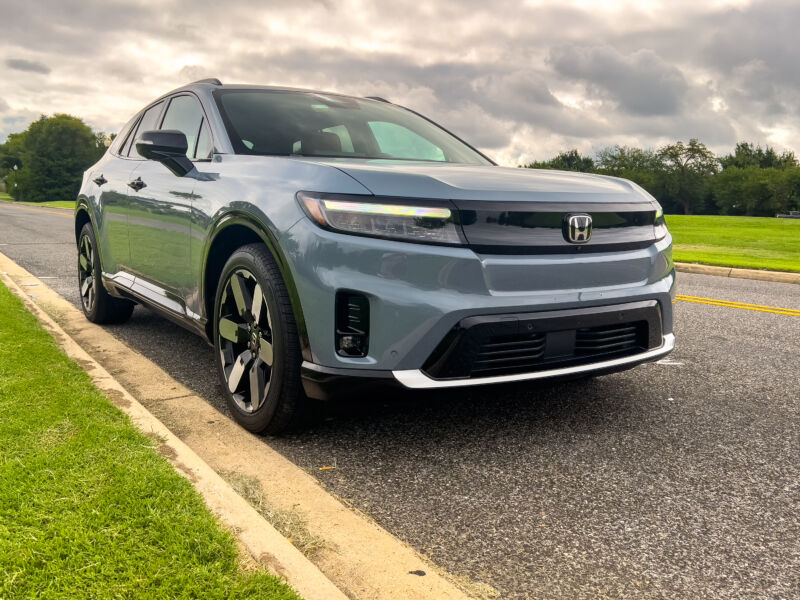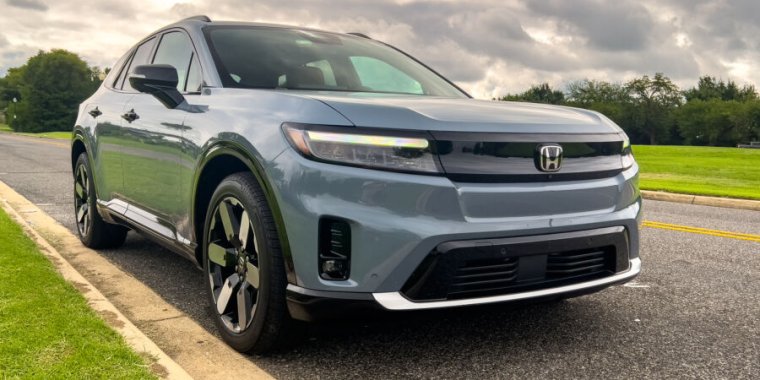
Jonathan Gitlin
Electric vehicles aren’t quite as hot as they were when Honda first showed us the Prologue in 2022. Designed around General Motors’ new platform of Ultium batteries and motors, it was planned to be the first in a series of EVs to benefit from this platform-sharing with GM. But late last year, that plan was shelved. Instead, Honda will focus on a homegrown family of EVs, investing $11 billion on North American production alone. That makes the Prologue rather accurately named, but it’s also something of a dead end, as it’s built on an underlying architecture that won’t be seen again wearing the Honda wings.
The Prologue is a midsize SUV, so it’s larger than a CR-V. It’s identical in size to the Chevrolet Blazer, and the twin-motor all-wheel drive powertrain in our test Prologue Elite generates the same 288 hp (214 kW) and 333 lb-ft (451 Nm), fed by the same 85 kWh capacity Ultium battery pack.
That shouldn’t be too surprising—the Prologue comes from the same GM factory in Ramos Arizpe, Mexico, as the Blazer EV. But Honda was responsible for signing off on the ride and handling and, as with the more upmarket Acura ZDX, also took charge of the car‘s UI/UX. And the result is an EV that does not feel like a Blazer EV to drive, nor to sit in, mostly.
At 5,273 lbs (2,392 kg), the Prologue is not a light car, but it still manages to weigh less than either the AWD Blazer EV or the (remarkably heavy) Acura ZDX. There’s no option for air springs on the Prologue, even on the top-trim Elite, but the conventional springs and dampers in the multilink suspension did a notably better job of filtering out harshness from the road than the Blazer EVs I drove last December.
-
The Prologue is 192 inches (4,877 mm) long, 78.3 inches (1,989 mm) wide, and 65.2 inches (1,656 mm) tall.
Jonathan Gitlin -
It’s the best-looking Ultium-based car I’ve seen so far. It also got the thumbs up from at least one motorist during the week—a young man and his dog out for a drive in a late-’90s Jaguar XJR, which is not the sort of thing you forget.
Jonathan Gitlin -
You can use a foot gesture to open the rear hatch, which is actually quite useful if you have arms full of groceries.
Jonathan Gitlin -
There are physical buttons and knobs for the climate control, just not the headlights.
Jonathan Gitlin -
The floor is completely flat, and there’s quite a lot of room for passengers back here.
Jonathan Gitlin -
The Prologue is 192 inches (4,877 mm) long, 78.3 inches (1,989 mm) wide, and between 64.7-65.2 inches (1,643-1,656 mm) tall, depending on trim.
Jonathan Gitlin
I’m not sure Honda has even published a 0–60 figure in its tech specs for the Prologue, and despite telling us that the car has “sporty Honda driving character,” I didn’t find any of that evident during our week with the car. You’ll want to make sure there’s a good gap in traffic before pulling out from a side street to make a left turn, given its rate of acceleration. And as you approach full throttle, the front wheels start to torque-steer thanks to tires that prioritize low rolling resistance over lateral grip.
On the other hand, I found the Prologue a pleasant car to drive slowly, despite it being on the larger side of things. The steering was smooth and responsive, and in its strongest setting, the one-pedal driving mode was very well-calibrated for the 20–30 mph (32–48 km/h) speed zone that covers most city driving these days.
The Prologue’s infotainment made it near-impossible to get a good idea of long-term range efficiency, resetting its display with each journey. In the height of the hottest summer on record here in DC, at least 20 percent of each trip’s energy use was devoted to running the air conditioning, and between that and the 21-inch wheels and all-wheel drive powertrain of the Elite trim, the best I saw displayed was 3 miles/kWh (20.7 kWh/100 km).
The Elite has the shortest EPA range of all the Prologue trims at 273 miles (439 km). But all of them can fast-charge at the same speed, taking 35 minutes to get from 20 to 80 percent. During charging, the Prologue maintained a relatively high rate across the entire 35 minutes rather than tapering off rapidly, as is common with earlier EVs.
-
A DC fast charge should only take 35 minutes to hit 80 percent.
Jonathan Gitlin -
EA chargers now tell you how much power the car is requesting as well as how much power the charger is feeding it.
Jonathan Gitlin

